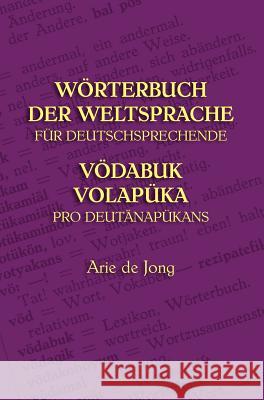Wörterbuch der Weltsprache für Deutschsprechende: Vödabuk Volapüka pro Deutänapükans » książka
Wörterbuch der Weltsprache für Deutschsprechende: Vödabuk Volapüka pro Deutänapükans
ISBN-13: 9781904808893 / Volapuk / Twarda / 2012 / 542 str.
VolapUk is a constructed language, devised in 1879 by Johann Martin Schleyer, a Roman Catholic priest who was inspired in a dream to create an international language. Schleyer adapted the vocabulary of VolapUk mostly from English, supplemented by German, French. and Latin. The grammar of VolapUk is regular and relatively simple-surprisingly easier, in fact, than it looks at first. VolapUk was the first proposed International Auxiliary Language to enjoy widespread popularity: it is estimated that in 1889, there were some 283 clubs, 25 periodicals in or about VolapUk, and 316 textbooks in 25 languages, and that some-where between two hundred thousand and a million people had taken up study of the language. Esperanto, being similar to many European Romance languages, first appeared in 1887, and ultimately proved more popular. Today, the number of people studying VolapUk is much lower than once it was, though Internet contacts have enabled VolapUk enthusiasts to connect and communicate, and that new community has inspired the re-publication of this dictionary. This German-VolapUk VolapUk-German dictionary is the most complete modern dictionary of VolapUk currently available. It has been out of print for many years, and it is hoped that its re-publication will assist a new generation of VolapUk learners in their enjoyment of this unique language.
Volapük is a constructed language, devised in 1879 by Johann Martin Schleyer, a Roman Catholic priest who was inspired in a dream to create an international language. Schleyer adapted the vocabulary of Volapük mostly from English, supplemented by German, French. and Latin. The grammar of Volapük is regular and relatively simple-surprisingly easier, in fact, than it looks at first. Volapük was the first proposed International Auxiliary Language to enjoy widespread popularity: it is estimated that in 1889, there were some 283 clubs, 25 periodicals in or about Volapük, and 316 textbooks in 25 languages, and that somewhere between two hundred thousand and a million people had taken up study of the language. Esperanto, being similar to many European Romance languages, first appeared in 1887, and ultimately proved more popular. Today, the number of people studying Volapük is much lower than once it was, though Internet contacts have enabled Volapük enthusiasts to connect and communicate, and that new community has inspired the re-publication of this dictionary. This German-Volapük Volapük-German dictionary is the most complete modern dictionary of Volapük currently available. It has been out of print for many years, and it is hoped that its re-publication will assist a new generation of Volapük learners in their enjoyment of this unique language.











